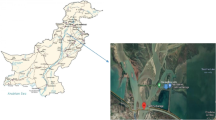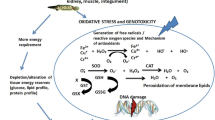Abstract
The results of the comparative study of molecular biomarkers of oxidative stress and biotransformation of some representatives of the families Cyprinidae and Mugilidae from estuaries of rivers which enter Peter the Great Bay are presented. The haarder mullet Liza haematocheila is used as an indicator species for monitoring the degree of environmental pollution. The basic values of biochemical parameters in different organs of haarder mullet and their seasonal variations have been determined. A significant increase in the concentration of glutathione and activity of glutathione-S-transferase in fish from the Razdolnaya River has been found on the basis of the comparison of the functional state of haarder mullet in estuaries of the Razdolnaya and Amba rivers, which differ in the degree of anthropogenic load.
Similar content being viewed by others
References
Aleshko, S.A. and Luk’yanova, O.N., Seasonal changes in some parameters of biotransformation and antioxidant system in the liver of barfin plaice Liopsetta pinnifasciata in the Amur Bay in the Sea of Japan, Biol. Morya, 2008, vol. 34, no. 2, pp. 148–151.
Aleshko, S.A., The effect of petroleum hydrocarbons on marine organisms at the molecular level, Izv. TINRO-Tsentra, 2007, vol. 148, pp. 247–261.
Avci, A., Kacmaz, M., and Durak, I., Peroxidation in muscle and liver tissues from fish in a contaminated river due to a petroleum refinery industry, Ecotoxicol. Environ. Saf., 2005, vol. 60, pp. 101–105.
Bartell, S.M., Biomarkers, bioindicators, and ecological risk assessment-a brief review and evaluation, Environ. Bioindicators, 2006, vol. 1, pp. 60–73.
Basova, M.M., The role of liver in the generative process in righteye flounders (by the example of Black Sea turbot Psetta maeotica), Ekol. Morya, 2000, no. 52, pp. 64–67.
Dauvin, J.-C., Paradox of estuarine quality: benthic indicators and indices, consensus or debate for the future, Mar. Pollut. Bull., 2007, vol. 55,iss. 1–6, pp. 271–281.
Doyotte, A., Cossu, C., Jacquin, M., et al., Antioxidant enzymes, glutathione and lipid peroxidation as relevant biomarkers of experimental or field exposure in the gills and the digestive gland of the freshwater bivalve Unio tumidus, Aquat. Toxicol., 1997, vol. 39,is. 2, pp. 93–110.
Emmersen, B.K. and Emmersen, J., Protein, RNA and DNA metabolism in relation to ovarian vitellogenic growth in the flounder Platichthys flesus (L.), Comp. Biochem. Physiol., 1976, vol. 55B,is. 2, pp. 315–321.
German, A.V. and Kozlovskaya, V.I., Hepatosomatic index and biochemical composition of the liver of bream Abramis brama in the Sheksna Reach of the Rybinsk Reservoir at different levels of accumulation of organic toxicants, Vopr. Ikhtiol., 2001, vol. 41, no. 2, pp. 249–252.
Greenberg, C.G. and Gaddock, P.R., Rapid single-step membrane protein assay, Clin. Chem., 1982, vol. 28, no. 7, pp. 1725–1726.
Habig, W.H., Pabst, M.J., and Jacoby, W.B., Glutathion-S-transpherase: the first step in mercapture acid formation, J. Biol. Chem., 1974, vol. 249, pp. 7130–7139.
Kafanov, A.I., Labai, V.S., and Pecheneva, N.V., Biota i soobshchestva makrobentosa lagun severo-vostochnogo Sakhalina (Biota and Macrobenthos Communities in Lagoons of North-Eastern Sakhalin), Yuzhno-Sakhalinsk: Sakh. Res. Inst. Fish. Okeanogr., 2003.
Kashulin, N.A., Lukin, A.A., and Amundsen, P.A., Ryby presnykh vod Subarktiki kak bioindikatory tekhnogennogo zagryazneniya (Fish in Fresh Waters of Subarctic as Bioindicators of Technogenic Pollution), Apatity: KNTs RAN, 1999.
Korolyuk, M.A., Ivanova, L.I., Maiorova, I.G., and Tokarev, V.S., Method of determination of catalase activity, Lab. Delo, 1988, no. 1, pp. 16–19.
Kovekovdova, L.T. and Simokon’, M.V., Assessment of the content of metals and arsenic in bottom sediments and fish in rivers of the basin of Peter the Great Bay (Sea of Japan), Izv. TINRO-Tsentra, 2010, vol. 160, pp. 223–235.
Lemaire, P., Fönlin, L., and Livingstone, D., Responses of hepatic biotransformation and antioxidant enzymes to CYP1A-inducers (3-methylcholanthrene, β-naphthoflavone) in sea bass (Dicentrarchus labrax), dab (Limanda limanda) and rainbow trout (Oncorhynchus mykiss), Aquat. Toxicol., 1996, vol. 36, pp. 141–160.
Lisitsyn, A.P., Flows of sediments, natural filters and sedimentary systems of ”living ocean,” Geol. Geofiz., 2004, vol. 45, no. 1, pp. 15–48.
Luk’yanova, O.N., Ireikina, S.A., Chernyaev, A.P., et al., Ecotoxicological assessment of some estuarine zones in southern Primorie, Izv. TINRO-Tsentra, 2010, vol. 162, pp. 214–225.
Luk’yanova, O.N., Molecular biomarkers in ecological monitoring of marine ecosystems, Izv. TINRO-Tsentra, 2003, vol. 133, pp. 271–281.
Men’shchikova, E.B., Lankin, V.Z., Zenkov, N.K., et al., Okislitelnyi stress. Prooksidanty i antioksidanty (Oxidative Stress. Prooxidants and Antioxidants), Moscow: Slovo, 2006.
Moron, M.S., Pepierre, J.W., and Monnervick, B., Level of glutathione, glutathione reductase and glutathione-S-transferase activities in rat lung and liver, Biochem. Biophys. Acta, 1979, vol. 582, pp. 67–78.
Nemova, N.N. and Vysotskaya, R.U., Biokhimicheskaya indikatsiya sostoyaniya ryb (Biochemical Indication of Fish State), Moscow: Nauka, 2004.
Nigmatulina, L.V., Assessment of anthropogenic load of coastal sources on the Amur Bay (Sea of Japan), Vestn. DVO RAN, 2007, no. 1, pp. 73–77.
Novikov, N.P., Sokolovskii, A.S., Sokolovskaya, T.G., and Yakovlev, Yu.M., Ryby Primor’ya (Fishes of Primorie), Vladivostok: Dal’rybvtuz, 2002.
Odum, Yu.P., Ekologiya (Ecology), vol. 2, Moscow: Mir, 1986.
Oven, L.S., Rudneva, I.I., and Shevchenko, N.F., Response of scorpion fish Scorpena porcus (Scorpaenidae) to anthropogenic pollution, Vopr. Ikhtiol., vol. 40, no. 1, 2000.
Ozcan Oruc, E. and Usta, D., Evaluation of oxidative stress responses and neurotoxicity potential of diazinon in different tissues of Cyprinus carpio, Environ. Toxicol. Pharmacol., 2007, vol. 23,is. 1, pp. 43–51.
Ozcan Oruc, E., Sevgiler, Y., and Uner, N., Tissue specific oxidative stress responses in fish exposed to 2,4-D and azinphosmethyl, Comp. Biochem. Physiol. Pt. C. Toxicol. Pharmacol., 2004, vol. 137,is. 1, pp. 43–51.
Porter, N.A., Nolon, Y., and Ramdas, L., Cyclic peroxides and thiobarbituric assay, Biochem. Biophys. Acta, 1976, vol. 441, pp. 506–512.
Ross, S.W., Dalton, D.A., Kramer, S., and Christensen, B.L., Physiological (antioxidant) responses of estuarine fishes to variability in dissolved oxygen, Comp. Biochem. Physiol. Pt. C. Toxicol. Pharmacol., 2001, vol. 130,is. 3, pp. 289–303.
Sheehan, D., Meade, G., Foley, V.M., and Dowd, C., Structure, function and evolution of glutathione transferases: implication for classification of non mammalian members of an ancient enzyme superfamily, Biochem. J., 2001, vol. 360, pp. 1–16.
Sostoyanie morskikh ekosistem, nakhodyashchikhsya pod vliyaniem rechnogo stoka (State of Marine Ecosystems under Effect of River Runoff), Vladivostok: Dal’nauka, 2005, p. 261.
Spivak, E.G., Posledstviya vozdeistviya khlororganicheskikh pestitsidov i tyazhelykh metallov na bychkov Azovskogo morya (Consequences of the Effect of Chlororganic Pesticides and Heavy Metals on Goby in the Sea of Azov), Rostov-on-Don: AzNIIRKh, 2010.
Vasconcelos, R.P., Reis-Santos, P., Fonseca, V., et al., Assessing anthropogenic pressures on estuarine fish nurseries along the Portuguese coast: a multi-metric index and conceptual approach, Sci. Total Environ., 2007, vol. 374,iss. 2–3, pp. 199–215.
Zhang, J.F., Shen, H., Xu, T.L., et al., Effects of long-term exposure of low-level diesel oil on the antioxidant defense system of fish, Bull. Environ. Contam. Toxicol., 2003, vol. 71, pp. 234–239.
Zonta, R., Guerzoni, S., Pérez-Ruzafa, A., and de Jonge, V.N., Measuring and managing changes in estuaries and lagoons: morphological and eco-toxicological aspects, Mar. Pollut. Bull., 2007, vol. 55,iss. 10–12, pp. 403–406.
Author information
Authors and Affiliations
Corresponding author
Additional information
Original Russian Text © S.A. Danilenko, O.N. Luk’yanova, 2014, published in Voprosy Ikhtiologii, 2014, Vol. 54, No. 1, pp. 87–96.
Rights and permissions
About this article
Cite this article
Danilenko, S.A., Luk’yanova, O.N. Biochemical markers of commercial fish adaptation in estuaries of Peter the Great Bay (the Sea of Japan). J. Ichthyol. 54, 85–94 (2014). https://doi.org/10.1134/S0032945214010032
Received:
Accepted:
Published:
Issue Date:
DOI: https://doi.org/10.1134/S0032945214010032




